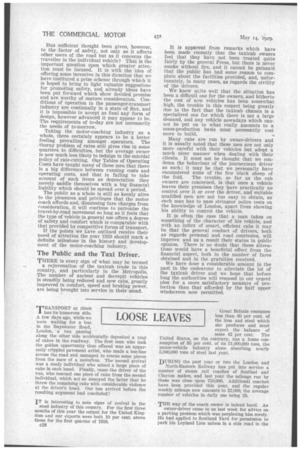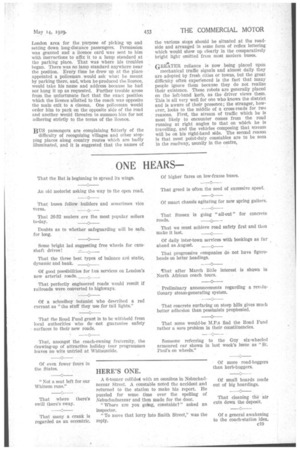T RANSPORT at times .I. has its humorous side. A few
Page 48

Page 49

If you've noticed an error in this article please click here to report it so we can fix it.
days ago, while we LOOSE were waiting for a bus in the Bayswater Road,
London, a van passing along the other side accidentally deposited a tray of cakes in the roadway. The first man who took the golden opportunity thus offered was an apparently crippled pavement artist, who made a bee-line across the road and managed to rescue some pieces from the maw of a motorbus. The second arrival was a seedy individual who seized a large piece of cake in each hand. Finally, came the driver of the van, who rescued one piece of cake from the second individual, which act so annoyed the latter that he threw the remaining cake with considerable violence at the driver's head. Our bus arrived before the resulting argument had concluded!
IT is interesting to note signs of revival in the steel industry of this country. For the first three months of this year the output for the United,Kingdom and our exports were both 10 per cent. above those for the first quarter of 1928.
018 Great Britain consumes less than 60 per cent. of the iron and steel which she produces and must export the balance of some 42 per cent. The United States, on the contrary, has a home consumption of 95 per cent, of its 51,000,000 tons, the motor-vehicle industry alone absorbing nearly 5,000,000 tons of steel last year.
LEAVES
DURING the past year or two the London and North-Eastern Railway has put into service a number of steam rail coaches of Sentinel and Clayton makes, and last year the mileage run by these was close upon 750,000. Additional coaches have been provided this year, and the regular weekly mileage now amounts to 82,000, the average number of vehicles in daily use being 29.
THE way of the coach owner is indeed hard. An owner-driver came to us last week for advice on a parking problem which was perplexing him sorely. He had applied to Scotland Yard for permission to park his Leyland Lion saloon in a side road in the London area for the purpose of picking up and setting down long-distance passengers, Permission was granted and a licence card was sent to him with instructions to affix it to a lamp standard at the parking place. That was *here his troubles began. There was no lamp standard anywhere near the position. Every time he drew up at the place appointed a policeman would ask what he meant by parking there, and, when he produced the licence, would take his name and address because he had nor hung it up as requested. Further trouble arose from the unfortunate fact that the exact position which the licence allotted to the coach was opposite the main exit to a cinema. One policeman would order him to park on the opposite side of the road and •another would threaten to summon him for not adhering strictly to the terms of the licence.
BUS passengers are complaining bitterly of the difficulty of recognizing villages and other stopping places along country routes which are badly illuminated, anti it is suggested that the names of the various stops should be situated at the roadside and arranged in some form of reflex lettering which would show up clearly in the comparatively bright lightemitted from most modern buses.
GRATER reliance is now being placed upon • mechanical traffic signals and almost daily they are adopted by fresh cities or towns, but the great difficulty often experienced is the fact that many people ignore them because they do not realize their existence. These robots are generally placed on the left-hand kerb, as the driver views them. This is all very well for one who knows the district and is aware of their presence; the stranger, however, looks to the middle of a cross-roads for two reasons. First, the stream of traffic which he is most likely to encounter comes from the road running at right angles to that on which he is travelling, and the vehicles composing that RT. eam will be on his right-hand side. The second reason is that most point-duty constable are to be seen in the roadway, usually in the centre,




























































































































